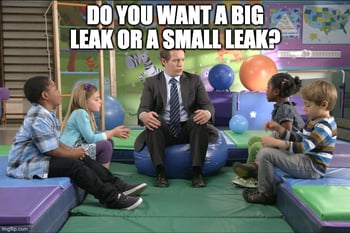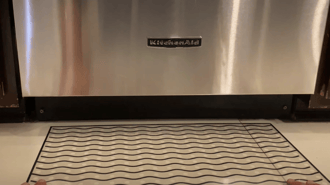Innovative Water Loss Control Solutions for High-Rise Residential Properties
Discover Kairos Water's innovative solutions for preventing water damage in high-rise residences with Point of Leak Detectors (POLDs).
Features
About Us
Support
Partners
Water leaks in apartments are common occurrences. In a single-family residence, a water leak is severe. In an apartment community, that same leak could be catastrophic, causing a cascading nightmare for property management: unplanned capital expenses, rent loss, reputational damage, and countless other negatives.
Water damage is a $20B annual problem for multi-family property owners, and 75% of all water damage comes from in-unit leaks. However, the technology used to detect leaks in multifamily has not been up to the challenge. That’s why, in 2022, the fear of water leaks keeps property managers awake at night.
In this article, we examine some of the coverage gaps caused by existing leak sensors and explore the capabilities of current leak sensors.
First, let’s meet one of those sleepless property managers.

Pete, the Property Manager, works on-site at your apartment community. He has to juggle many different responsibilities - keeping the rent collected and ensuring the maintenance crew does their job to make his tenants happy.
He’s kind and hard-working, and his team has relied on leak detection technology for the past 15 years. Pete is very aware of the limitations of water sensors since he has been getting leak alerts on his phone since the iPhone 4 and has been ignoring them since the iPhone 8 (R.I.P. to the button). Leak detection keeps him as safe as bullet-proof boxers, but, as he says, something is better than nothing.
Quickly resolving resident issues makes his property management group happy because happy residents are more likely to renew - and pay increased rent when they do!
*Disclaimer - Adam Driver is not a property manager
Pete is constantly addressing issues and responding to maintenance requests so that you can keep the residents safe and happy.
One of the most critical things Pete has to watch out for is water damage threats. Water leaks in apartments are common occurrences and can cause a cascading effect of negative issues for management.
If Pete overlooks or misdiagnoses a leak, it could cost him and his company a lot of money in repairs.
That's why Pete needs to look for signs of water leaks in his apartment complex.
What do you think of when we hear about a leak? Is it big? Is it small? Do I need to fix it right now?
If you're an apartment owner, you must be aware of the potential for water damage in your building. Leaks can occur in many places, from the roof to the plumbing, and they can be challenging to detect and repair. By being proactive about leak detection, you can save yourself time and money in the long run.
75% of all water damage events in apartment buildings occur in-unit.
With so many unknowns, diagnosing a potential leak with any nuance or context is impossible.
Being proactive, however, is the real challenge. How do you know what action is needed to stop the leak?
Is the leak visible? How big is the leak?
Answering these questions is often the missing piece of the puzzle. Without understanding the context of a leak and its severity, reactions can vary, and leaks can get misdiagnosed, causing the property team to let a small leak become a severe threat or overlook a leak that needs immediate attention.
Current leak detection technology puts Pete in a challenging position. He cannot be everywhere at once, but someone - likely Pete - needs to inspect each leak to diagnose the threats appropriately.
One day, Pete gets a notification from the building's system about a water leak in one of the units. He's not too worried at first because leaks are common occurrences in apartments. But then he gets notifications about the same leak, over and over again.
After a while, Pete gets tired of the notifications and begins to ignore them. But then, one day, he receives a call from the building owner. They're upset because there was a costly water damage event in one of the units, and it turns out that it was the same leak that Pete had ignored because he didn’t know if it was a big leak or a small leak.
We face problems daily, but many don't know how to deal with them effectively. We often ignore notifications about potential issues, thinking they're unnecessary or that we'll deal with them later. But as Pete, The Property Manager, learned, this can be a costly mistake.
What is more dangerous, a big leak you know about right when it happens or a small leak that builds over time?

The answer is ‘neither.’ Most dangerous is being unable to tell the difference between a big leak and a small leak.
Leaks come in all shapes and sizes, but not all leaks are created equally. Small leaks are often easier to overlook and ignore. They might not seem like an immediate threat, but they can be just as catastrophic as large leaks if they're not addressed.
For example, one drop per second from a small leak like a toilet can result in 77 gallons of water loss per week.
The unforeseen risk of small leaks is why it's essential to be aware of the severity of leaks, no matter their size. By understanding the threat that small leaks pose, you can take steps to address them before they cause significant damage.
So, what exactly is severity context? In short, it's the idea that the consequences of a leak (or any other problem) can vary depending on the situation. For example, a small leak in an isolated area might not cause much damage. But if that same leak had the potential to affect the units below it in a matter of weeks, the narrative changes. It is essential to consider the severity of any leak, no matter how small it may seem. By doing so, you can take steps to prevent significant damage before it occurs.
Apartments present some of the riskiest scenarios for leaks. With hundreds of units to monitor, the maintenance team’s ability to monitor leaks is limited to places they can access or see. For example, if there is a leak in a resident’s unit and they are away, the property team will have trouble accessing it to check on the severity of the leak. An even more significant problem arises when the leak is underneath a dishwasher or washing machine, where standard puck sensors cannot fit.
Visibility into the safety of a unit brings an emphasis on the legal responsibilities properties have to their residents. Properties are responsible to their residents for ensuring their physical safety from all sorts of perils: security, fire, and in this case, water.

Here at Kairos, we have developed a unique solution to the problem of hard-to-monitor places. We have a patented flexible printed membrane that you can easily apply to those tough-to-reach spots.
Using severity context, teams can apply the right level of urgency to the correct problems. Understanding the size, speed, and location of the leak - and getting that information in real-time - puts Kairos’ customers in a uniquely advantageous situation compared to property managers relying on flood detectors to detect leaks.
Remember Pete, the Property Manager from before?
Imagine a maintenance team on a hot summer day with large volumes of resident requests. When a leak alert arrives, they open their phone to check the notification. It shows that there is a small leak in a 3rd-floor unit that is coming from the dishwasher. Now knowing this threat is not a large leak, and even though it has the potential to cause catastrophic damage over time, the team prioritizes the leak appropriately, given it does not have to drop everything to address it at this very moment. The team can give the maintenance requests from residents the attention they need. At the end of the day, after all the residents have been taken care of, the team makes their way to the 3rd floor and takes care of the leaking dishwasher.
With a stronger focus on the efficiency of maintenance teams in apartment communities, Kairos recommends that the following be implemented as part of any commercial or multifamily water damage mitigation strategy.
Leak detection solutions should provide context on the severity of leaks when the sensors alert team members to avoid fatigue and to miss serious events.
Ease Of Upkeep
Following the initial deployment of a solution, how often does your leak detection system require action from the team to keep operational? Usually, these factors boil down to how frequently something like the battery needs to be changed. Considering the whole apartment community, this can be a significant burden on the team as it requires them to go into each unit and check each sensor. Therefore, we equipped our sensors with a 10+ year battery life.
Often leak detection solutions require energy taxing and large bandwidth networks such as WiFi or ZigBee to support their sensors. Since these antiquated networks need a hub in each unit, they are very taxing on energy use. They can result in data coverage issues if a unit loses connectivity and goes undetected. We choose to utilize a LoRaWAN network in our gateways so that one can support up to 5 floors in an apartment community.
Detecting leaks and water threats in apartment communities require a reactive approach from the maintenance teams. Upon receiving an alert, they must act fast. However, without the context or the severity of a leak, they will just be getting the same warning, regardless of if it is a big or small leak.
Discover Kairos Water's innovative solutions for preventing water damage in high-rise residences with Point of Leak Detectors (POLDs).
Discover how smart water management solutions like leak sensors and automatic shut-off valves impact insurance for commercial and multifamily...
Commercial buildings have a far higher risk with water damage. In this post, learn the key differences between residential and commercial leak...
© 2025 Kairos Water, Inc. All Rights Reserved.

